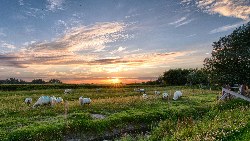Sheep and Beef Sector Increases Eco-efficiency
3 MAY 2013
FOR IMMEDIATE RELEASE
Sheep and Beef Sector Increases
Eco-efficiency
New research shows the New
Zealand sheep and beef sector has a much lighter
environmental footprint than in the past.
Beef +
Lamb New Zealand Chief Executive Dr Scott Champion says a
recent paper by Dr Alec McKay, published in the Proceedings
of the New Zealand Grasslands Association, used the Overseer
model to look at the changes in the relationship between
inputs (eg, livestock numbers, nutrients) and outputs (eg,
meat and fibre, greenhouse gas emissions,
nitrate).
The research was conducted using the
Ministry for Primary Industries sheep and beef farm
monitoring models that cover hard hill country (Gisborne and
Central North Island) and easy hill finishing (Manawatu)
over the last 20 years.
“For the hard hill
country, extensive sheep and beef farm operation, the
productivity gains made since 1989-90 translate into
significant eco-efficiency gains,” Dr Champion
said.
“We have seen a 47 per cent increase in
saleable product per hectare, a 21 per cent reduction in
nitrate leaching per kilo of saleable product, and a 40 per
cent reduction in the greenhouse gas emissions per kilo of
saleable product.”
For more intensive sheep and
beef operations in the easy hill finishing country, the
gains have been more modest.
The study aligns with
similar greenhouse gas reductions already seen from the
sector.
Dr Champion said the sheep and beef
industry’s enormous productivity gains over the last
20-plus years have been made through a combination of new
technologies. These include advances in animal genetics and
health and improvements in farm practices, such as nutrient,
pasture, and animal management.
“Beef + Lamb New
Zealand Economic Service data shows the national average
lambing percentage has gone up from 100 to 120 per cent
since 1990, lamb carcass weight per ewe from 13 to 17kg and
wool per head from five to six kilos.
“Even
though dairy conversions have seen a decline in the land
area used for sheep and beef farming, the export value of
sheepmeat and beef has more than doubled since 1990 – from
less than $2.5 billion to more than $5
billion.
“Our greenhouse gas emissions are also
below 1990 levels while production has remained roughly
constant. It’s the same for our water footprint, where we
are producing more but nutrient leaching has not increased.
This is the result of focusing on productivity rather than
just putting more animals on the land.”
With a
growing focus on environmental issues – and freshwater
quality in particular – it is gratifying to be able to
demonstrate that the sheep and beef sector has maintained a
nitrate leaching profile at very low levels, Dr Champion
said.
“What this research shows is that it is
possible to improve productivity without adversely affecting
the
environment.”
ENDS


 Federated Farmers: Government Ends War On Farming
Federated Farmers: Government Ends War On Farming University of Auckland: NZ Researchers Drive Work On International AI Framework
University of Auckland: NZ Researchers Drive Work On International AI Framework Woolworths: Rolling Out Team Safety Cameras To All Stores As Critical Tool For De-escalating Conflict
Woolworths: Rolling Out Team Safety Cameras To All Stores As Critical Tool For De-escalating Conflict  Consumer NZ: Environmentally Conscious Shoppers At Risk Of Being Greenwashed
Consumer NZ: Environmentally Conscious Shoppers At Risk Of Being Greenwashed Hugh Grant: Facing The Future - The Use Of Biometric Tech
Hugh Grant: Facing The Future - The Use Of Biometric Tech John Mazenier: Gaffer Tape And Glue Delivering New Zealand’s Mission Critical Services
John Mazenier: Gaffer Tape And Glue Delivering New Zealand’s Mission Critical Services



